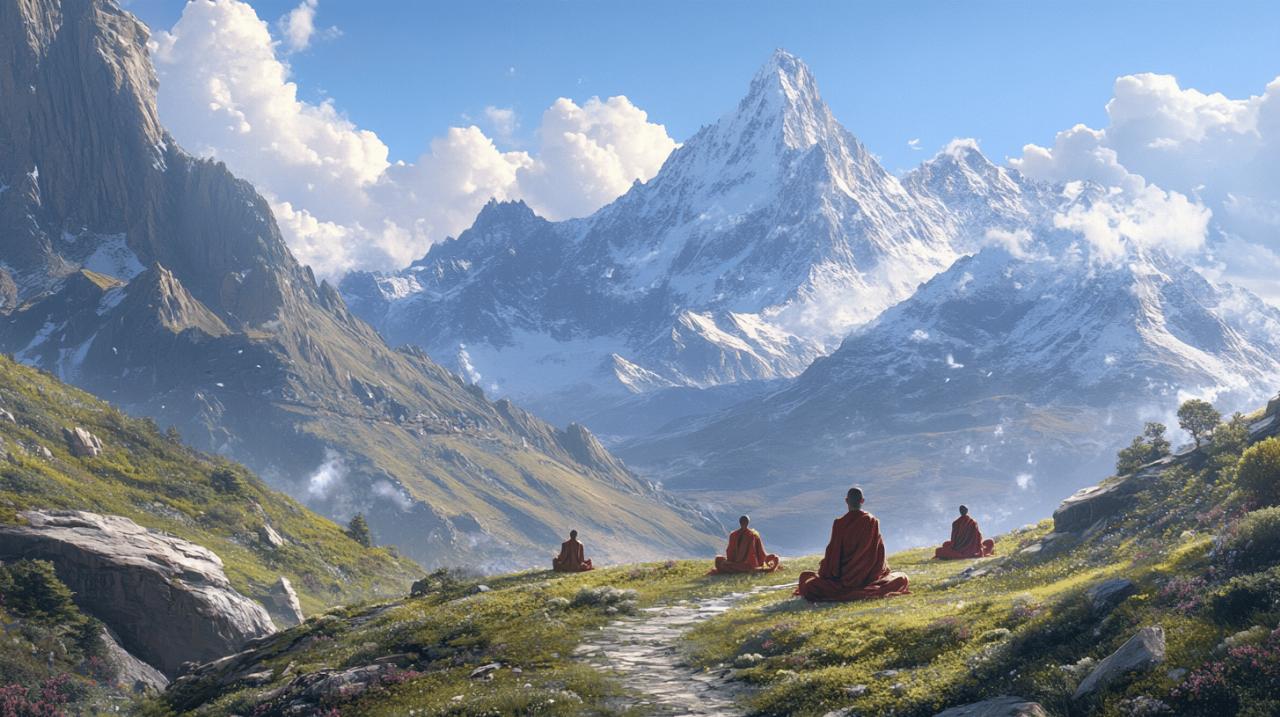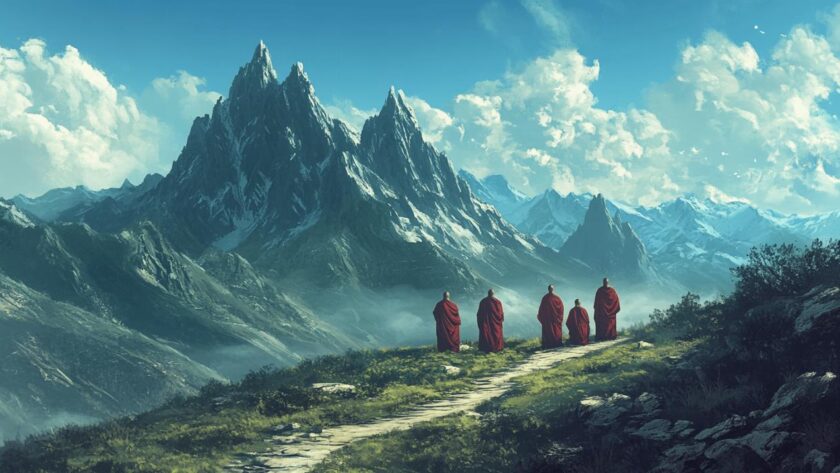Tibet stands as a mystical destination where spirituality and adventure intertwine against the backdrop of the world's highest mountains. This sacred land invites travelers seeking both inner peace and physical challenge through its ancient meditation practices and majestic trekking routes. The spiritual journey through Tibet offers unique opportunities to connect with centuries-old Buddhist traditions while exploring some of Earth's most breathtaking landscapes.
The sacred landscape of tibet
Tibet's topography serves as more than just scenery—it functions as a living spiritual canvas where natural formations and human-built structures create spaces for profound contemplation. From snow-capped peaks to crystal-clear lakes, each element of the Tibetan landscape holds spiritual significance that has drawn pilgrims and seekers for millennia.
Majestic himalayan backdrops for spiritual practice
The Himalayan range provides an awe-inspiring setting for meditation and mindfulness practices. At elevations reaching beyond 4,000 meters, locations like Lake Yamdrok-Tso and Lake Namtso offer pristine environments where the thin air and vast horizons naturally shift consciousness toward meditative states. Traditional Tibetan practices such as Zazen meditation take on new dimensions at high altitudes, where the physical challenge of limited oxygen merges with mental discipline to create unique conditions for spiritual growth. Mindful walking along ancient pilgrim paths around sacred sites like Mount Kailash—with its 52-kilometer circumambulation route—transforms simple trekking into contemplative hiking that connects practitioners with both nature and their inner landscapes.
Ancient Monasteries as Centers of Wisdom
Dotting the Tibetan plateau, monasteries like Potala Palace in Lhasa (3,650m) stand as architectural marvels and living repositories of Buddhist wisdom. These centuries-old structures house sacred texts, artifacts, and living traditions that continue to guide spiritual seekers. The Jokhang Temple buzzes with devotional energy as pilgrims perform prostrations and spin prayer wheels in acts of reverence. Monasteries such as Sera and Drepung function as educational centers where monks engage in philosophical debates and preserve traditional knowledge. The trek between Ganden Monastery and Samye Monastery offers visitors a physical journey that mirrors the spiritual path, connecting ancient centers of learning through landscapes that have inspired meditation for generations. These sacred spaces serve not only as historical monuments but as active channels to Tibet's spiritual heritage.
Tibetan meditation practices
Tibet stands as a sanctuary for those seeking spiritual depth through ancient meditative traditions. Set against the breathtaking Himalayan landscape, this sacred land offers unique opportunities to explore traditional meditation techniques while trekking through valleys and visiting monasteries. The spiritual journey to Tibet intertwines physical movement with mental stillness, creating a powerful path to inner transformation.
Traditional techniques for inner peace
Tibetan meditation encompasses distinctive practices that have been preserved for centuries. Zazen meditation at high altitudes presents a particularly powerful experience, combining rigorous sitting postures with the natural oxygen scarcity of the Tibetan plateau. This practice builds both mental focus and physical endurance, pushing practitioners beyond ordinary limitations. Another significant practice is Vipassana meditation, which guides practitioners to connect deeply with the present moment by cultivating awareness of bodily sensations and thoughts without judgment. These meditation techniques find their most profound expression at sacred sites like the Potala Palace in Lhasa (3,650 meters), where the spiritual energy of centuries of practice creates an ideal environment for deeper states of consciousness.
Mount Kailash (6,638 m) represents one of Tibet's most revered meditation locations, considered sacred by Hindus, Buddhists, Jains, and Bon followers. The mountain remains unclimbed out of respect for its spiritual significance. Pilgrims often touch the base of the mountain to receive blessings, believing in its power to facilitate spiritual awakening. The practice of silence features prominently in Tibetan meditative traditions, with practitioners using the vast, quiet landscapes as natural amplifiers for their inner journey.
Integrating meditation into daily trekking
Contemplative hiking through Tibetan valleys transforms ordinary trekking into a moving meditation. The ancient pilgrim routes, such as the 52-kilometer Kailash Kora circumambulation around Mount Kailash, serve as paths for mindful walking. This practice involves focusing completely on each step, breath, and surrounding element, promoting deep concentration and serenity even while in motion. The varied landscapes—from mountain passes like Dolma La to sacred waters like Lake Mansarovar (4,590 meters) and Lake Yamdrok-Tso (over 4,400 meters)—naturally inspire and enhance the meditation experience.
The journey from Ganden Monastery to Samye Monastery offers another opportunity to practice meditation while trekking, combining physical challenge with spiritual growth. These treks require both physical preparation and mental resilience, as the high altitudes demand adaptability and patience. Travelers learn to synchronize their breathing with their walking rhythm, creating a natural flow state that dissolves the boundary between meditation session and daily activity. This integration represents the essence of Tibetan spiritual practice—finding mindfulness not just in formal sitting sessions but throughout all activities, making every step on Tibet's sacred soil part of the path to inner peace.
Exploring tibetan yoga traditions
 Tibet, nestled high in the Himalayas, offers a sacred space for spiritual seekers drawn to its ancient wisdom and meditative practices. This mystical land at elevations ranging from 3,650 meters in Lhasa to over 4,700 meters at sacred lakes like Namtso serves as a living repository of unique yogic traditions. The journey through Tibet intertwines physical trekking with profound spiritual experiences, creating opportunities for inner transformation against the backdrop of breathtaking landscapes and monasteries.
Tibet, nestled high in the Himalayas, offers a sacred space for spiritual seekers drawn to its ancient wisdom and meditative practices. This mystical land at elevations ranging from 3,650 meters in Lhasa to over 4,700 meters at sacred lakes like Namtso serves as a living repository of unique yogic traditions. The journey through Tibet intertwines physical trekking with profound spiritual experiences, creating opportunities for inner transformation against the backdrop of breathtaking landscapes and monasteries.
Tibetan yoga differs significantly from its Indian counterparts, incorporating elements specific to high-altitude living and Buddhist philosophy. These practices have been preserved for centuries in remote monasteries and valleys, where silence and nature act as essential components for spiritual awakening. Sacred sites such as the Potala Palace, Mount Kailash, and Tashilhunpo Monastery have long been destinations for those seeking not just adventure but genuine inner peace.
The unique elements of tibetan yoga
Tibetan yoga incorporates distinctive practices shaped by the region's geography and spiritual heritage. One remarkable practice is high-altitude Zazen, which combines rigorous sitting meditation with the naturally reduced oxygen levels found in Tibet. This creates a uniquely challenging environment that simultaneously tests and builds both mental focus and physical endurance. The practice takes on special significance when performed at sacred locations like Lake Yamdrok-Tso (4,400+ meters) or during the 52-kilometer circumambulation around Mount Kailash (6,638 meters).
Another core element is the integration of mindful movement with meditation through contemplative hiking. This practice transforms treks through Tibetan valleys into moving meditation sessions. The journey from Ganden Monastery to Samye Monastery exemplifies this tradition, where pilgrims practice deliberate, conscious steps while maintaining awareness of breath, surroundings, and internal states. The magnificent Himalayan landscapes—mountains, sacred lakes, and forests—serve not merely as scenery but as active participants in the meditative experience, inspiring practitioners and deepening their connection to both the natural world and their inner landscape.
Learning from local masters
Studying with authentic Tibetan yoga masters offers insights impossible to gain elsewhere. These teachers, many of whom have dedicated decades to practice in remote monasteries like Sera and Drepung near Lhasa, share techniques refined over generations. Their instruction goes beyond physical postures to include breathing exercises specially adapted for high altitudes, visualization practices connected to Tibetan Buddhist deities, and methods for cultivating mindfulness amid challenging conditions.
The teaching approach emphasizes direct transmission from master to student, creating a lineage connection that Tibetans believe enhances the potency of the practices. Many masters incorporate Vipassana meditation techniques, guiding students to develop present-moment awareness by paying careful attention to bodily sensations and thoughts. This instruction often happens within significant spiritual contexts—during pilgrimages to Lake Manasarovar, while visiting the Jokhang Temple, or walking the sacred Barkhor Street circuit. These locations, steeped in centuries of spiritual energy, are believed to facilitate deeper learning and transformation when working with a knowledgeable guide who can interpret their significance and harness their power for yogic development.
Cultural immersion and spiritual growth
Tibet beckons travelers seeking a profound spiritual journey amid the majestic Himalayas. This mystical land offers a unique blend of meditation practices, sacred landscapes, and ancient wisdom that creates a transformative experience for those who visit. Nestled at high altitudes, Tibet provides an environment where trekking and spiritual practices harmoniously merge, allowing visitors to explore both external landscapes and internal realms of consciousness.
Sacred sites: jokhang temple and potala palace
At the heart of Tibet's spiritual landscape stand the magnificent Jokhang Temple and Potala Palace in Lhasa. The Jokhang Temple, situated at 3,650 meters above sea level, serves as Tibet's most revered religious structure where pilgrims gather to worship and practice mindfulness. Nearby, the iconic Potala Palace rises dramatically against the Himalayan backdrop, its white and red walls housing centuries of Tibetan Buddhist history and sacred artifacts. These sites function as catalysts for inner peace, where visitors can engage in Zazen meditation practices despite the oxygen scarcity at high altitudes. Many spiritual seekers participate in contemplative hiking around these monuments, practicing mindful walking that promotes concentration and serenity while connecting deeply with Tibet's rich Buddhist heritage. Beyond Lhasa, the trek from Ganden Monastery to Samye Monastery offers another profound spiritual path through breathtaking landscapes that inspire deeper meditative experiences.
Embracing local cuisine and buddhist traditions
Immersion in Tibetan culture extends beyond sacred monuments to daily rituals and culinary traditions that nourish both body and spirit. While trekking through valleys or visiting sacred lakes like Yamdrok-Tso (4,400 meters) and Namtso (4,718 meters), travelers can engage with local customs that have remained unchanged for centuries. Tibet's spiritual practices often incorporate Vipassana meditation, which teaches practitioners to connect with the present moment by paying attention to bodily sensations and thoughts—a practice particularly powerful when performed amid Tibet's stunning natural environments. Many spiritual journeys include participating in circumambulation rituals, particularly around Mount Kailash, where the sacred 52-kilometer trek (known as Kailash Kora) serves as both physical challenge and spiritual pilgrimage. This circular path represents the journey toward enlightenment, with each step taken in mindfulness under the watchful peaks that have inspired seekers for millennia. The best times for these spiritual treks are during spring (April to June) and autumn (September to October), when weather conditions support both physical wellness and spiritual awakening in this ancient kingdom.




